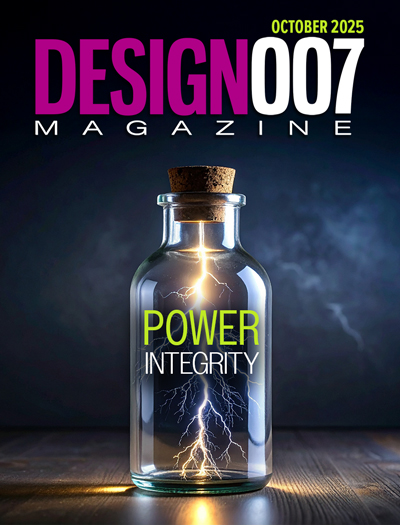-

- News
- Books
Featured Books
- design007 Magazine
Latest Issues
Current Issue
Power Integrity
Current power demands are increasing, especially with AI, 5G, and EV chips. This month, our experts share “watt’s up” with power integrity, from planning and layout through measurement and manufacturing.

Signal Integrity
If you don’t have signal integrity problems now, you will eventually. This month, our expert contributors share a variety of SI techniques that can help designers avoid ground bounce, crosstalk, parasitic issues, and much more.

Proper Floor Planning
Floor planning decisions can make or break performance, manufacturability, and timelines. This month’s contributors weigh in with their best practices for proper floor planning and specific strategies to get it right.
- Articles
- Columns
- Links
- Media kit
||| MENU - design007 Magazine
Cannonballs, eBooks, and Signal Integrity
December 4, 2017 | Andy Shaughnessy and Pete Starkey, I-Connect007Estimated reading time: 12 minutes
Starkey: I did particularly enjoy the analogy that you've presented at a few conferences regarding this pile of cannonballs that you pass on your way to the office in the morning.
Gaudion: Yes (laughs).
Shaughnessy: How does that figure in? Tell us that story.
Gaudion: Well, the Huray method starting off was called the snowball method. The idea was that the dendrites on the copper looked like a messy pile of snowballs, but actually to get the dimensions and areas of the snowballs off an SEM is quite complicated and there's lots of different dimensions and work to do. So what Bert Simonovich said is, “If we made all the dimensions the same and actually piled them up like a stack of cannonballs, we could use one diameter and a certain base and use a cannonball stack method.”
I was actually driving on the way up to the office and there was a lovely big pile of cannonballs, and I took a photo on the way past, so I use that as the opening slide and I have this picture of cannonballs just stacked there, and people are thinking, "What's this about? I came here to learn about signal integrity, not about cannonballs."
Starkey: As you and I have said many times: All models are wrong, but some are useful.
Gaudion: And that's from a statistician called George E. P. Box, and again, some people think models are actually perfect but we all know that base materials are composite of glass fiber and resin systems and when they're pressed together the ratios of glass and resin change, and so you don't have an exact number on anything.
Starkey: And as a PCB fabricator, if you could achieve a good bond between metal and resin with a super smooth copper, it would make the signal integrity calculations much more straightforward.
Gaudion: It would, yes. We wouldn't make as much money on modeling!
Starkey: Yes, but you wouldn't assemble many multilayer boards because they'd all fall apart in the oven. Everything's got to be a realistic compromise, considering an awful lot of factors and parameters that go into making the finished product.
Gaudion: And that's an interesting point. I was saying that I’ve been speaking to automotive suppliers, but also, for the first time, chemistry suppliers are coming in saying, "Polar, we need to speak to you about roughness, because we're developing a new process that will give smoother copper and we'd like to analyze its impact on signal integrity." So we've started to speak to different people that historically Polar wouldn't really be involved with.
Starkey: I come from a process background myself, and I think the chemistry suppliers have responded very positively to the input that you've made.
Gaudion: That's good.
Starkey: Because as you say, you can specify a foil but then what does the fabricator do to that foil in process? When he buys a thin laminate, the foil that comes as part of the laminate has got known characteristics, with a degree of roughening on the side corresponding to the resin. Then subsequently he has got to make the other surface bondable, so he puts it through some sort of chemical roughening process to give a key for his laminating process. In the past it was something that didn't take into account any signal integrity consideration.
But largely as a consequence of the presentations that Martyn and Neil have done, the process guys now recognize the significance of it, and it's precipitated the development of a whole new range of bonding treatments that don't result in a surface that causes any further complication of the already complicated subject of maintaining signal integrity.
Shaughnessy: So if you're working with the chemical companies then, you'll be able to test their chemicals using impedance testing?
Gaudion: Or we'll give them the tools to test, yes. And certainly some of the laminate suppliers are now using our systems and software to qualify their new materials. It's a very interesting time to be in the industry at the moment and it's good that everyone's busy as well.
Shaughnessy: Somebody was telling me that if they have their boards built in China, that they use shops that have Speedstack. Because people who have no English skills whatsoever can still use Speedstack. It's handy across the language barrier.
Gaudion: We've done a lot of work in terms of many of our products being available in traditional Chinese, simplified Chinese, they're available in German, and they’re available in English - we provide our tools in a number of different languages.
Shaughnessy: Is there anything that you want to talk about that we haven't covered yet? Anything you're working on, or anything you want to talk about in the future?
Gaudion: This year, in terms of signal integrity, we've added the signal integrity tools and incorporated them within Speedstack. We've got a very rich materials library database, about 17 different base material suppliers that are available online within Speedstack, and now you can generate a high-speed stack up and actually specify the insertion loss from within the stack up tool and provide all the graphs for insertion loss, along with the materials you're going to use, the number of layers, and all the information the supplier needs. So that's a big, big improvement.
But I always remind people that when you talk about materials, sometimes designers have a myth of a perfect material library that if they could spec the material perfectly they wouldn't need to speak to the PCB fabricator. But just recalling what Pete said, actually they still do. So it's important that we all keep talking with each other.
Shaughnessy: They’d rather not talk to anybody (laughs).
Gaudion: Yes, that would be my summary.
Shaughnessy: Thank you, Martyn.
Starkey: Yes, thanks very much indeed for your time Martyn. It’s been a very meaningful discussion.
Gaudion: Thank you.
Visit I-007eBooks to download your copies today:
The Printed Circuit Designer’s Guide to…Secrets of High-Speed PCBs, Part 1
The Printed Circuit Designer’s Guide to…Secrets of High-Speed PCBs, Part 2
Page 2 of 2Testimonial
"Your magazines are a great platform for people to exchange knowledge. Thank you for the work that you do."
Simon Khesin - Schmoll MaschinenSuggested Items
Episode 6 of Ultra HDI Podcast Series Explores Copper-filled Microvias in Advanced PCB Design and Fabrication
10/15/2025 | I-Connect007I-Connect007 has released Episode 6 of its acclaimed On the Line with... American Standard Circuits: Ultra High Density Interconnect (UHDI) podcast series. In this episode, “Copper Filling of Vias,” host Nolan Johnson once again welcomes John Johnson, Director of Quality and Advanced Technology at American Standard Circuits, for a deep dive into the pros and cons of copper plating microvias—from both the fabricator’s and designer’s perspectives.
Nolan’s Notes: Tariffs, Technologies, and Optimization
10/01/2025 | Nolan Johnson -- Column: Nolan's NotesLast month, SMT007 Magazine spotlighted India, and boy, did we pick a good time to do so. Tariff and trade news involving India was breaking like a storm surge. The U.S. tariffs shifted India from one of the most favorable trade agreements to the least favorable. Electronics continue to be exempt for the time being, but lest you think that we’re free and clear because we manufacture electronics, steel and aluminum are specifically called out at the 50% tariff levels.
MacDermid Alpha & Graphic PLC Lead UK’s First Horizontal Electroless Copper Installation
09/30/2025 | MacDermid Alpha & Graphic PLCMacDermid Alpha Electronics Solutions, a leading supplier of integrated materials and chemistries to the electronics industry, is proud to support Graphic PLC, a Somacis company, with the installation of the first horizontal electroless copper metallization process in the UK.
Electrodeposited Copper Foils Market to Grow by $11.7 Billion Over 2025-2032
09/18/2025 | Globe NewswireThe global electrodeposited copper foils market is poised for dynamic growth, driven by the rising adoption in advanced electronics and renewable energy storage solutions.
MacDermid Alpha Showcases Advanced Interconnect Solutions at PCIM Asia 2025
09/18/2025 | MacDermid Alpha Electronics SolutionsMacDermid Alpha Electronic Solutions, a global leader in materials for power electronics and semiconductor assembly, will showcase its latest interconnect innovations in electronic interconnect materials at PCIM Asia 2025, held from September 24 to 26 at the Shanghai New International Expo Centre, Booth N5-E30


